Here are the tables showing how many UCI points are available in every kind of road race. It’s not the stuff of dreams, but if you need to know how many UCI points are on offer in hurry it can be a nightmare to get the answer. Visit the UCI website, find the rules pages, select the right PDF to download and then scroll past 70 pages. Here it’s all on one page.
The big news for 2023 is the points have changed significantly with the grand tours, monuments and world championships becoming even more lucrative and gone are the days when a win in the Elfstedenronde or Paris-Chauny brought more points than a Tour de France stage win.
First, the table below is for the World Tour races, if it’s a stage race then it’s for the final overall classification. What’s new for 2023 is that the grand tours get more points and there’s a new column where the five monuments get more points over other races, plus the Strade Bianche is upgraded too.

Next comes the points per stage in the World Tour stage races. This has been almost doubled for the grand tours, plus across all stage races points are now awarded well beyond first five or top three as before, now it’s down to 15h place or 10th respectively.
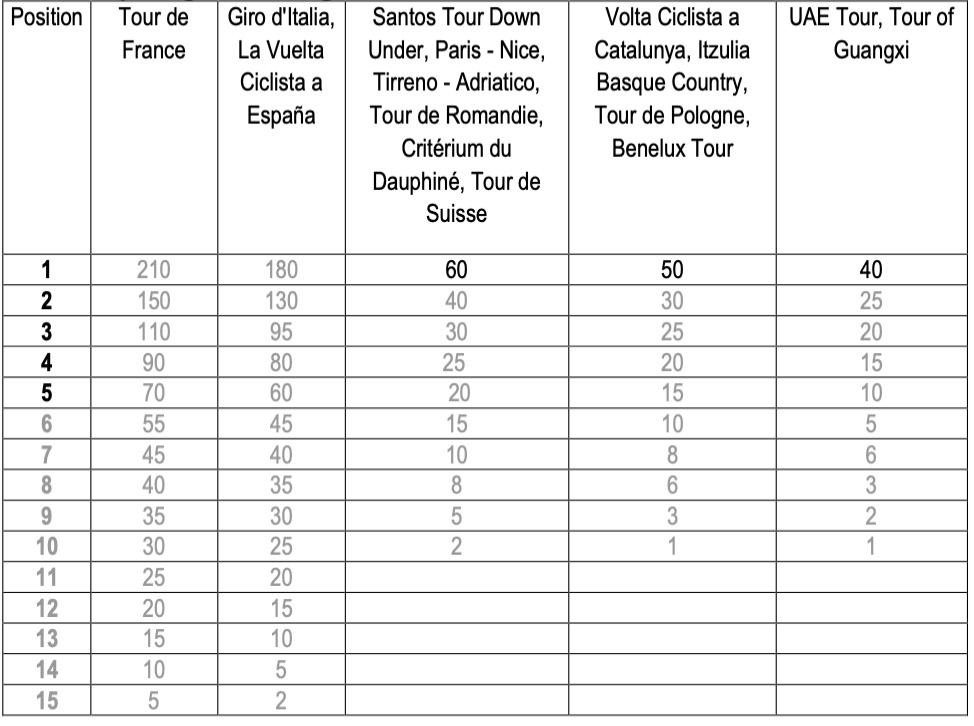
Next you can see points on offer for final place in the secondary competitions of a grand tour, the mountains and points competition and new for 2023, this is almost doubled too. For a practical example of what this all means, in the last two Tours Tadej Pogačar and Jonas Vingegaard have got, give or take, 1,800 points with 1,000 for the overall win then more from stage wins, placings and also taking the mountains competition. Apply the new points scale and they stand to collect 2,700 points for similar results.

Next comes a daily award for leading a World Tour stage race, a nice bonus but one that’s more in media attention than points. It’s unchanged for 2023.

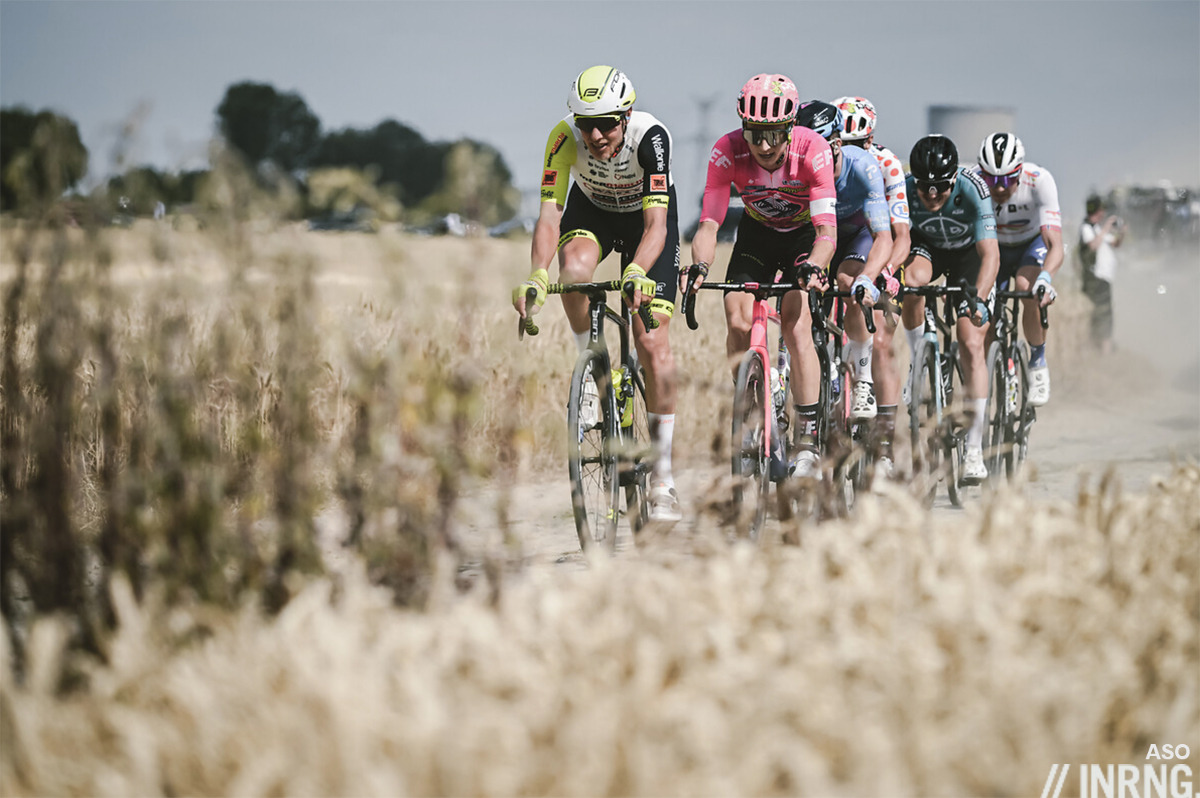
Now comes arguably the most important table here because it’s for races outside the World Tour and this is where teams hunting points can find a lot of rewards because of the breadth of the calendar. Winning a stage race overall or winning a one day brings the same points haul, which makes one day races very important. The season-opening Challenge Majorca races are a good case study, they are each Class 1 races and so win one day’s racing and a rider banks 125 points, but if it was a stage race only the final overall would bring this many points.
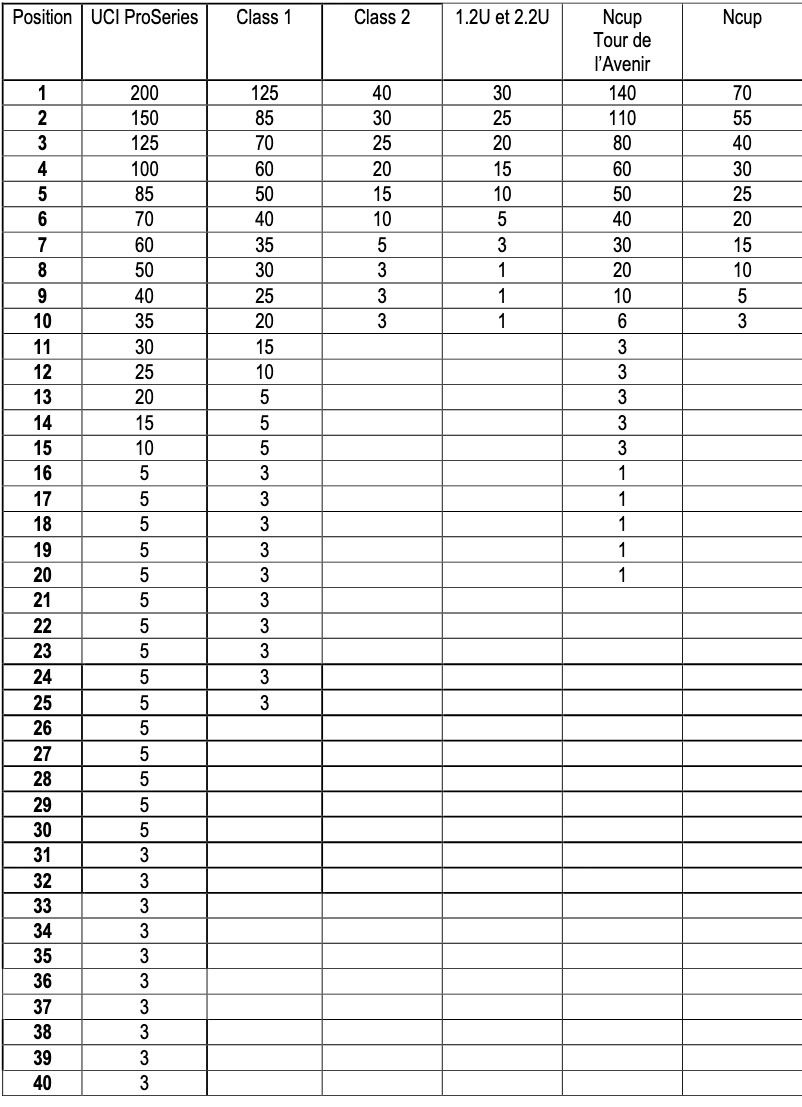
Next two tables below shows the points on offer for stages in non-World Tour races and the daily points for leading the race too, the change for 2023 is more points for the podium in a .Pro race and points to fifth.


Next comes the national championships, split into A and B groups, where A is defined as a nation that started at least one rider in the previous Men’s Elite world championship road race. These points matter because often when we look at the teams with few wins and placings in the year, several of their best results can be from national championships in smaller nations, the kind with only a few pros. Sometimes we’ve seen big name riders skip their national championships but smaller teams hunting points ought be paying business class return for their lesser riders to go and grab the jersey and points.
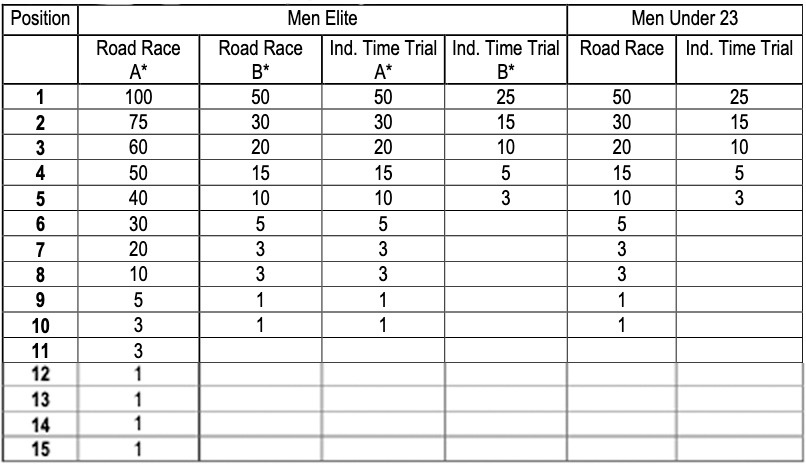
Now comes the Continental Championships, think the European championships for the best example. Other regions are supposed to have them but they can be thin on the ground. 2022 has Asia, Oceania and Europe in the calendar for now. If these championships have a team time trial and/or a mixed relay time trial event, the small table below also applies.
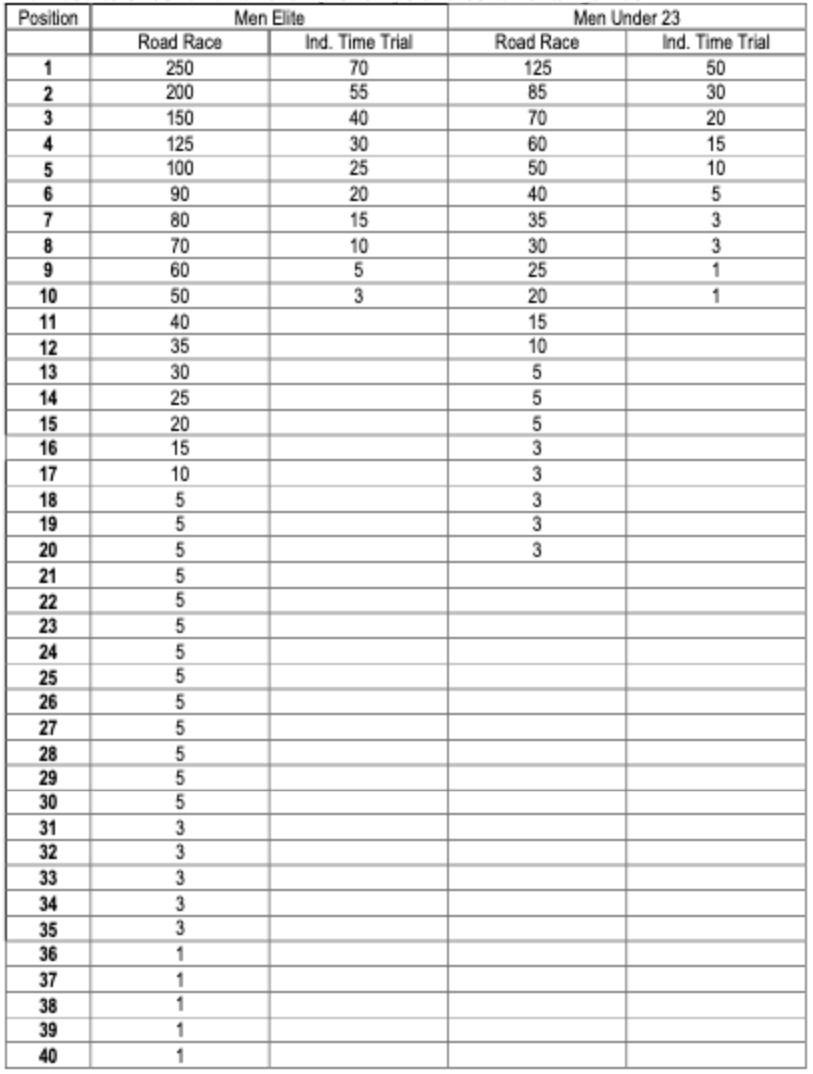
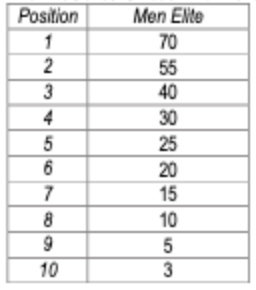
Now for the Worlds and Olympics, obviously big events but the UCI is keen to big them up even more with the points on offer and for 2023 they get a big increase, the winner got 600 for the road race before, now it’s 900 making the Worlds and Olympics the most lucrative one day races when it comes to points.

For the last of the tables, here’s the mixed relay time trial at the worlds which the UCI is keen on promoting, it’s 300 points but this is divided by the three men, so 100 points each (of course the women get 100 each too).
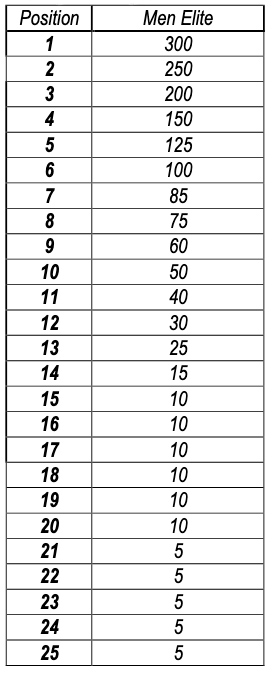
How to forfeit points
As well as winning points by results, riders can lose them. The UCI rules include various penalties for bad behaviour, including points deductions. They concern cheating like taking short-cut, to using sidewalks, ignoring level-crossing red lights, littering and other misdemeanours, right down to failing to sign on for the day’s racing or show up for the post-race press conference if invited. Any team manager worried about scoring points should remind riders of all of these.

Rankings and points don’t matter…
…if they did then they’d be readily available and easily understood. One reason for this blog post is so I can have all this season’s points tables on one ready page for reference. These points still count for the teams and their promotion-relegation issues and Tour de France qualification. In the coming days we’ll look at the points race in 2023 and beyond…
- update: see The 2023 Points Race for a look at the promotion/relegation and points hunting quests ahead


I must say that the UCI exceeds its woke thought process and distance from supporters with its insistence on a mixed relay time trial. This is an event that is guaranteed to gain minimum support. What next and egg and spoon race, mixed of course on time trial bikes!
You don’t have to like or bother to watch the mixed gender events, but they are very much not only the fashion but the demand of the day quite regardless of what the UCI thinks.
(No need to bring the whole “woke” issue into it, in my humble opinion. If it has anything to do with anything here in the first place.)
The UCI is merely following the example set by other sports federations. There will be a mixed team event in skijumping and in Nordic combined at the World Championships in Plance (and there are mixed relays in the cross-country World Cup calendar, There will be a mixed event at the Alpine World Championships in Meribel. There will be a mixed relay at the Biathlon World Championships in Oberhof.
As you suggest, it’s the UCI copying fellow Olympic federations and there are other mixed relay events in the Olympics. But also it’s a way to make events at the championship last across the week of the championships, an extra day’s racing but without too much extra distance or cost the riders. The UCI can’t put up big prize money but 100 points each per rider is an incentive (and also a potential clash between national selectors and team managers).
The O-word is the end game with this.
The total number of athletes that cycling (all disciplines added together) can have at the Olympics is fixed, so the best option for the UCI to get more IOC money is to find ways to increase the number of cycling events while still staying within that quota of athletes.
If the TTT relay doesn’t get onto the Paris 2024 program, my prediction is that it will be swiftly dropped from the World Championship program.
There won’t be any mixed events in cycling in Paris:
https://en.wikipedia.org/wiki/Cycling_at_the_2024_Summer_Olympics#Competition_schedule
(I must admit I was a bit surprised. But it’s probably on its way to Los Angeles in 2028…)
Mixed Relay has been a part of the MTB Worlds for years; and a lot of the big hitters ride in it; one lap a few days before their race.
CX had a test event at last year’s Worlds and it seemed to work….
…”woke”…
*plonk*
This was your takeaway from this article? Petty political grievances and zero understanding of what “woke” is?
I love watching the mixed relay. Easily the most exciting race in the worlds calendar unless you get a corker in one of the road races
I always wanted to see Fixed Gear Tandem Madison Cyclo-cross.
Mixed of course
Thank you, ZKelly, I got a laugh out of that in an increasingly esoteric debate
Fixed-gear / single-speed cyclo-cross is kind of a thing 😉
https://tracklocross.bike/2021/01/08/what-is-tracklocross/
Mixed in what sense? On each tandem or single sex tandem, mixed team? I need this information.
I wonder why they have the Olympics on the points list for 2023 when there is no Olympics this year. By next year the points might have changed again!
These are standing regulations, not a yearly program.
Is there any reason for the points going so deep in the more minor races (eg 1pt for 60th at Amstel!)?
Seems to be an un-necessary complication.
3 points for 60th in Amstel. It’s a meagre reward, in a way it makes sense to sprint for 60th place everything else being equal rather than pull out with a lap to go. But it is a tiny reward and probably not so significant. Remember relegation last year saw about a thousand points difference between staying up and relegation, a bit more than this for qualifying as one of the top two teams from last year to get an automatic invite.
Perhaps a neopro or conty rider in a big race would actually get exited to score a few points as a reward for sticky out the race and riding with passion hard as they could right to the end.
And who knows of 3 or 4 riders stick it out and score 3 – 5 points each *10 – 15 extra for the team) over 3 years and many races it will add up to hundreds. If i was a race director any rider not saving for the next race would be under instructions to ride hard to the end if there in the points.
Now that teams’ scores are based on their top 20 riders rather than their top 10, it’s conceivable that these extra points might make more of a difference. Would be interesting* to know whether counting the top 20 would have made a difference to the relegation places last time round.
* but not interesting enough for me to work it out.
Is it still the same ruling for the Proteams that it’s on a yearly basis so the top two get an invite to Grand Tours the following year?
Yes, and we’ll take a closer look at this soon.
Volta and Itzulia one step down when compared to the rest of the quite-established seven top one-week stage races (our host had a piece in 2016 which named precisely the obvious seven, as the Procycling 2021 feature by Pickering, or simply the bottom quicklink set on PCS) isn’t new but still a lame decision, really, especially given that they tick each and every possible quality box, from history to exciting courses, from vivid racing to big winners often against solid competition (just check the final GC podia). One really has to wonder why: it’s not like race category, which you can always suspect it was something the organisers asked or not, rather than the UCI conceded or not. These are all WT.
TDU on points-roids is of course a story apart, and although laughable it corresponds to a clear policy (same for the one-day Canadian races) – but this? What’s the rationale?
It was startinng from 2016 that Catalonia and Basque country were considered to be weaker or lesser races than the five other World Tour stage races. To me, too, it is a mystery why this was so – it indeed invites the conspiracy theorist in each of us to suggest that there must have been some kind of strange power political battle behind it 🙂
But once the two races were put in their place one step down, it is probably impossible to reinstate them in their rightful position without offending Tour de Pologne and the Benelux Tour…
As a mere and strongly biased proxy for actual race qualities, I just gave a look at the 2006-2016 average startlist value as calculated on PCS. Romandie is obviously the lowest scoring race at 760, then Catalunya at 770, then Dauphiné at 860, Itzulia at 920 and finally Suisse at 960.
And when I say that it’s a *biased* score, I mean that it’s mainly biased *against* the Spanish races in questoin for a different couple of reasons at least, one of them structural the second one quite contingent.
To start with, Romandie and Dauphiné are prep races, that is, the actual in-race competition was often lower than what the startlist mirrors; as some oddities in athletic preparation fall back into past history, these two races will probably go back to their traditional status.
A top rider rarely strove at his very best to win one of these, because such an attitude could hinder the Tour (or Giro) final result, and often famously did so.
OTOH, as they are or were prep races, a lot of big names were very happy to start in order to clock the miles in and hone form while getting, dunno, second or fourth or seventh.
Which of course doesn’t mean that the other races necessarily had always top competition – the Volta had a nefarious decade after its excellent 90s and first half of the 2000s, but then came back at a very high level once the Contador, Valverde, Purito, Quintana decided to have some of their duels on these roads. And I’d happily add Porte, whose impact and value in one-week races is well superior to his GT skills.
Although Pogacar or Vingegaard don’t include it in their programme, the race is still on a positive trend, with solid quality podia and exciting action. However, you sure don’t feel that anyone is holding back, or a step down, because he’s focussing on any close target coming up next.
The second bias is specifically related to Team Sky’s approach. They brought their big team as a dress reharsal to Romandie and Dauphiné and tried hard to win. The circular effect of their riders having a lot of points and hence bringing them into these races (as did some rivals eager to copycat) can be detected easily if one observes the curve of the startlists.
Dauphiné, surely the most significant among the two, had a startlist score over 900 in each and every season from 2011 to 2017 – it hadn’t ever ever exceeded that figure barring 2005. It never had exceeded 800, really.
Then, they only had a great startlist in 2020 (ending in a mediocre podium, really, but whatever), and hardly got over 900 in 2019, too (918). The rest is back to ordinary business, below the 800 points mark.
As a contrast, Itzulia stayed *below* the 800 points mark *only four times* in the last 30 years or so, and with anecdotal frequency (1994, 2010, 2019, 2022).
More or less the same is true for Romandie, albeit in a less clear way. Yet, you notice how the race consistently scored over 800 or close to 900 points in the 2013-2016 seasons, then it went back below 700 points where it typically belonged, barring some golden years in the second half of the 90s.
If one really wanted to split the big seven into a ladder of sort, it’s clearly Tirreno, Pa-Ni, Suisse, Itzulia on the one hand and Dauphiné, Catalunya and Romandie on a lower step. The only purpose of such a move would be precisely to allow some middle ground to promote shamelessly some products like ENECO (Benelux) Tour or Tour de Pologne, of course, because sporting reality is clear enough with seven of them above the rest for several reasons.
Anyway, splitting things as I suggested here, you’d also respect kind of a “balanced” national principle (which was how things tended to be done before the Pro Tour).
But, yeah, times definitely changed and the “new” attitude is “winner takes all” – the name of the spoil system is now vae victis. Short-term effective? Maybe. Intelligent or long-term productive? I’ve got some doubts. Luckily a reality principle of sort is still able to survive to board-games-style egemony, although one needs to wonder how long may it last. Cooperate or die.
Thanks for taking the time to post, your hard work is appreciated.
Slightly surprised Strade Bianche isn’t in the next group up, it will take a hell of a lot of winning in the likely deep quality field. Maybe it is because it is relatively new in relation to other more established races. Also San Sebastian to a lesser extent is always keenly disputed.
For this reader the following are, based on sporting and reputational criteria, at least one category too high: Santos, Montréal, Québec, Cadel Evans, Guangxi.
The points are a way of getting riders to Australia in January and Canada at the season’s end, and also an attempt to aid globalising the sport, but are hardly justified by other factors.
In the same way Catalunya, Itzulia and Strade Bianche look a category too low.
One issue I have with the points system that I haven’t seen mentioned elsewhere, is that many smaller races (certainly last season) are now being won by ‘bigger’ riders.
Many seem to think that having the ‘bigger teams’ at these smaller races is a good thing, but there is a downside.
Previously, a winner of one of these races may have been achieving the greatest victory of their career, either because they were an up-and-coming rider or because that was as high as they would go.
Now, those victories, which would be important for that rider, may well be taken by a ‘bigger’ rider who isn’t even particularly interested in said race and is only there for the points.
There is another side affect. Having pro teams at the event allows the promotor some advertising increasing the chances of sponsorship. In the low or negative margin business of running bicycle races every $ counts.
I,m a little envious of the ability to put on races. In Australia its so hard unless you have a purpose built track to put on anything but the biggest races that open road racing is in danger of disappearing in less populated regions.
There are also a lot more riders these days so it kind of makes sense that a strong rider that’s wont easily win a top tier race tries to convert his abilities into wins in the immediate sub-top tier. I guess the points do incentivize the team-leaders to align their own thinking with their rider’s in such a case.
Is there an easy ranking somewhere as to which teams lost the most points in penalties last season/3 year cycle? A reverse fair-play league, so to speak? Or does that require going through every single weekly update?
Any mention of points losses for dubious pre-season rap videos
On that topic, a special shout out to James Knox of Soudal-Quick Step for goading the commissaires into making him the first Cheaty McCheaterface disqualified from a WT race in 2023 – on the first full day of the season yesterday!
And indeed a prize to the TdU commissaires for encouraging riders to ignore the concussion protocols. Start as you mean to go on!
No, nothing easy or even difficult, you’d have to have every commissaire report and do it yourself or guess by working out results from every rider and then looking for any likely deductions, there’s no public record.
But it’s something that could be published, at least so this way we know where the deductions came and that the UCI results database is correct rather than assuming a shortfall in points is down to a fine/deduction when it could be wrong data entry. Maybe even have a bonus where the team with the least penalties gets a prize or more points etc.
So you’re telling me Strade Bianche isn’t the 6th monument?!
Since it’s a relegation year in the Women’s World Tour this year, I wondered if you’ll be doing any updates on that situation from time to time throughout the season?
Will keep an eye on it yes. Also partly depends on having a contest, eg more than 15 candidates for the World Tour. We can imagine AG and Ceratizit want to move up but be nice if they say “2024 World Tour promotion” out loud.
I’d almost put strade bianche in it’s own category just below the Monuments, or even in that group. It definitely deserves more credit than the Canadian races (in my own country, but c’mon, they are great races, but not as big as Strade).
So the GTs now have points for 24 stages with the climber’s, points and young rider jerseys all scoring as if they won a stage.
Whether it’s for a stage or a jersey, only 210 points this tariff seems low. Everyone wants to win a stage or jersey of the Tour, so no win is easy; yet you get 300 for a win in the Cadel Evans.
-and does anyone else think it’s an oddity that the only rider commemorated in a top-scoring WT event is -crikey- Cadel Evans..?!
On the Women’s World Tour side there is also the Trofeo Alfredo Binda.
Cadel winning the Tour was huge for Australian cycling. I imagine that after he retires, there will be a “Grand Prix Biniam Girmay” (or something to that effect) in Eritrea. I honestly don’t know why there aren’t any races with names in homage to Anquetil, Coppi or Merckx (to be fair, the Giro does have the “Cima Coppi,” but still..).
I’d imagine Evans lending his name and being involved helped get the race off the ground, he’s got clout than a local committee without Australia’s first tour winner wouldn’t have.
PS we’ve had the GP Eddy Merckx, there’s the Coppi and Bartali week race, the GP Miguel Indurain, the Elsy Jacobs Festival, the GP Le Samyn, and Per Sempre Alfredo in tribute to Martini.
The thread started about top-tier races, but surely RV’s references shifted the focus someway… so you can add to the mix the Memorial Marco Pantani or the GP F. VDB one. Gino Cerami also had his race. Sven Nys’ got his CX at Baal and van der Poel – senior – has Hoogerheide.
Settimana coppi e bartali? GP indurain? Memorial pantani? Go Jeff scherens?
I know in the past there has been controversy as riders from the same teams but different nations help their team mates at the worlds/olympics – increasing the points here – which benefit the teams not the nations only increased this risk doesn’t it?
And makes it even harder to watch as the jersey colour becomes less relevant and knowledge of teams more important. – my dad is confused enough when he watches with me and my explanations really frustrate him!
I don’t understand why any points should be allocated to nationals, worlds or Olympics. Trade teams don’t compete so should not benefit or be be impinged forb these. Bizarre
Might a trade team, as a rider’s employer, make it difficult for them to attend Worlds/Olympics/nationals if they clashed with a race that the team wanted to win? Giving the team points for these events mitigates that risk.
The counter argument is that a rider is paid and trained by their pro team, and rides on one of their bikes. But also here the UCI is both the arbiter of the sport but in the case of the Worlds, a sports promoter and to make sure the worlds is prestigious, a stack of points helps too. And as Nick suggests, it’s open to political issues, we saw a bit of this last year with national selectors and team managers clashing some times.
As commented on this subject before, the point system is *not* a way to understand or highlight which team did it better, but only a measure of sort of the potential sporting value we’d lose if a given team is relegated, *specifically* in order to relegate the ones which look less valuable for the sport as intended by the UCI.
Part of the system, of course, isn’t really measuring but twisting the measure system in order to *also* use it as a promotion of whatever races the UCI considers do need a good boost.
The above is made clear by not rewarding the best team and not giving more visibility to all this stuff.
Perhaps, in an historical paradox of sort, this “hidden” classification, born out of practical necessity, will generate more and more interest, to the point that teams will strive to get the top spot and people will eagery follow the whole evolution of the table.
Which as I said would be a paradox, indeed, because the UCI long tried and tried and tried to produce every sort of “general point classification”, be it individual, for teams, for nations ans so on and on, now for nearly two decades, but eventually dropped any project of that kind because they all failed one by one (remember that cool white ProTour leader jersey? Or the rolling point system as a measure of the real best rider?).
They needed inrng to succeed. And, of course, not actively trying to make it a successful thing.
This is totally unrelated to the above but having taken no interest in the Cav transfer saga, now I’m fascinated to hear INRNG’s opinion on his potential lead out…
Apologies but I’m going in on this briefly…
(& Cav could get quashed in all the lead up events making this conversation defunct before it’s even started but I’m still up for hearing people’s opinions! Or maybe I’ll get kicked over to CyclingNews with this chat!)
My take is that Astana’s TDF team get split between Cav and Lutsenko and the eight are:
1 Cav
2 Bol
3 Laas
4 Moscon
5 Fedorov
6 LL Sanchez
7 Felline
8 Lutsenko
My take is – if Moscon gets back to form then it’s all about getting LLS, Moscon and Fedorov to buy into the project and combine with Cav, Bol and Laas. And if Lutsenko goes for stages rather than GC then maybe add him into the mix also. If the unit all gain form together you’d expect Moscon and others to benefit and be able to seek out stage wins themselves alongside one day ambitions?
If Sanchez isn’t up for risking crashes in sprint finals, Moscon is selfish, Fedorov has other ambitions and Lutsenko wants more support for another high GC finish then maybe Cav will be left with fewer resources.
Either way a huge amount of work to do on the lead out even if everyone’s singing from the same hymn sheet – I worry Cav will need to spend so much time on team cohesion it’ll cost him focusing on his own form.
In my opinion Astana does not have much to play with when it comes to team leaders. So if it was my team I would put Cav in the Tour with Bol, Laas and a bunch of ok domestiques (Martinelli, Boaro, Gruzdev, Gidich) and maybe Sanchez. And play it all or nothing on Cav..
Leaving Lutsenko, Moscon, Batistrella, Felline, Feodorov, Romo, De La Cruz and Syritsa as a honestly still a pretty bare bones bunch for the other two GT’s. Also, I think Lutsenko has a chance of at least one podium if he does giro-vuelta. But him being the Astana posterboy might force him to go to the tour with no climbers to help him.
INRNG,
Thanks. I don’t often want to check out points for races but when I do, I know where to go. Impressive.
Hey, me neither, but that’s the point.
The points are very important to national federations too, for world championship and Olympic qualification. The rules are complicated but the bottom line is each country needs its top 8 men and top 5 women to score as many points as possible.
As for the mixed relay team time trial at worlds … let’s get rid of it and replace it with a criterium. Much more relatable to the global cycling population.
A criterium? Seriously? That is, selling cycling as a crazy arena for the frustrated athletes who can’t get serious but want to feel competition vibes all the same, or directly a staged farce among those who have to take competition seriously the rest of the times? 😛
Close to reality, yes, but inspiring? …perhaps not as much.
In most countries criteriums are real bike races, not the staged post-Tour events that are disappearing. They also don’t require much in the way of road closures, and they’re great for spectators.
Think short-track speed skating vs. long-track.
Yeah, my comment was sort of tongue in cheek, but I was referring to the supposed “real bike races” with the first part of my sentence above.
In Italy they’re rather common but they often end up in a sprint which grants to many athletes the expectation or the illusion for a decent placement anyway; racing in bigger teams matters a lot, probably too much, plus the whole thing becomes the reign of the slightly overweight and risk-prone MAMIL who couldn’t otherwise dream much in mass-start events with a lot of altitude gain or serious international competition.
Of course things go this way because Italy has a lot of opportunities for whomever is in need to add the competitive aspect to his or her road cycling passion, starting with, well, *real* real races, then, as I said above, a huge quantity of mass-start events of every kind, including shorter or flatter ones.
More or less the same (perhaps on a smaller scale) can be said for Spain, where the “vuelta al polígono industrial” is an affair on its own… for those who actually can’t race anywhere else.
Also note that normally given the importance which cycling still awards to, well, sheer number of victories, many times a decently fast man with criterium skills will get his chance to compete in some real semipro team although at the end of the day his overall quality isn’t that brilliant (which even became a problem for Italian cycling pro movement) or even if he lacks some fondo (!!!). So, this is a little crude, but, ehm, most crits end up being really for the leftover.
All that said, of course I suppose that if you don’t really have any other option in your context, crits can be just fine!
However, I agree that they’re real fun for the spectators, and that if properly managed they can become a low cost option to foster grassroot into the very smallest towns or provinces, maybe far from the sort of courses which hold more appeal for GFs.
Yet, I also must add that cycling should defend its right to close roads whenever necessary for the sake of its proven positive social impact. I mean, both cycling’s positive social impact… *and* that of road closures! – as such.
And I still wonder – if you’re focussing on the factors you name above – wouldn’t it be way better to push for CX? Even less road closures, even better for spectators, probably for athletes, too, and a more interesting technical range of skills. Good for the youngsters, even.